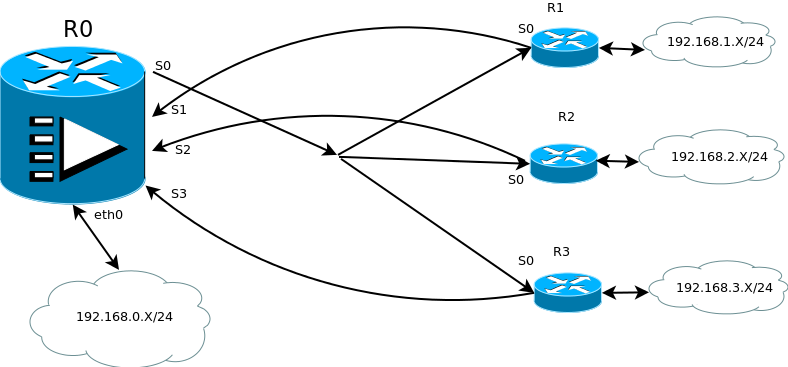- Cisco Community
- Technology and Support
- Networking
- Routing
- Question about broadcast serial network config
- Subscribe to RSS Feed
- Mark Topic as New
- Mark Topic as Read
- Float this Topic for Current User
- Bookmark
- Subscribe
- Mute
- Printer Friendly Page
Question about broadcast serial network config
- Mark as New
- Bookmark
- Subscribe
- Mute
- Subscribe to RSS Feed
- Permalink
- Report Inappropriate Content
01-04-2014 11:21 PM - edited 03-04-2019 09:59 PM
I want to know how to config the typical TDM/SCPC satellite network using cisco network.
For topology in Image 1.

the R0 broadcast downstream data from the serial port S0(V.35 FR HDLC), and will be recieved by router R1/R2/R3 in their Serial port S0. And the router R1/R2/R3 will send their upstream data from their Serial port s0 separately to s1/s2/s3 of R0. How could i config the network?
For topology in Image 2

If my network scale is large and there is not enough serial port in R0 ,could i extend with routers/switches by ethernet? how could i config the network like this? And which one should i use ,the router or switch, for the performence and cost consideration?
For topology in image3

If there is DDN for R4, typically E1 line with 2Mbps, so there is two connections for R4, one is DDN which is at speed of 2M and one is satellite connection which is at much lower speed ,typically 128Kbps or 256Kbps and i want to use the load balance feature for R4, how could I config the network?
- Labels:
-
Other Routing
- Mark as New
- Bookmark
- Subscribe
- Mute
- Subscribe to RSS Feed
- Permalink
- Report Inappropriate Content
01-05-2014 03:12 AM
hi sean,
for topology 1, the typical config on PE/teleport router (R0) to save up serial ports would look like something below.
your R0 will act as the FR switch and then configure VRFs and use static routes to spoke routers (and vice versa).
for topology 2, VSAT technology still use legacy equipment and I/O ports (not really a VSAT guy, so don't quote me here). we haven't use ethernet to scale up our ports.
#sh run int s2/7
Building configuration...
Current configuration : 290 bytes
!
interface Serial2/7 <<< TO TELEPORT MODEM
transmit-interface Serial5/0 <<< OUTBOUND INTERFACE
no ip address
ip flow ingress
encapsulation frame-relay <<<
no ip mroute-cache
load-interval 30
no keepalive
ignore dcd
serial restart-delay 0
cdp enable
end
#sh run int s5/0
Building configuration...
Current configuration : 254 bytes
!
interface Serial5/0
bandwidth 4096 <<< COMMON OUTBOUND BANDWIDTH
no ip address
encapsulation frame-relay <<<
no ip mroute-cache
load-interval 30
no keepalive
ignore dcd
serial restart-delay 0
end
#sh run int Serial2/7.148
Building configuration...
Current configuration : 250 bytes
!
interface Serial2/7.148 point-to-point <<< INBOUND
bandwidth 128 <<<
ip vrf forwarding
ip unnumbered Serial5/0.148 <<< TO SAVE IP ADD FOR P2P LINK
no ip mroute-cache
frame-relay interface-dlci 148 <<<
end
#sh run int Serial5/0.148
Building configuration...
Current configuration : 314 bytes
!
interface Serial5/0.148 point-to-point <<< OUTBOUND
bandwidth 128
ip vrf forwarding
ip address 192.168.1.1 255.255.255.252 <<< .2 REMOTE ROUTER
no ip mroute-cache
traffic-shape rate 128000 8000 8000 2048 <<< QOS
frame-relay interface-dlci 148 <<<
end
i'm not sure what you've meant with DDN for topology 3.
- Mark as New
- Bookmark
- Subscribe
- Mute
- Subscribe to RSS Feed
- Permalink
- Report Inappropriate Content
01-05-2014 04:43 AM
thanks for your reply, DDN means this E1 line which provides 2.048Mbps two-way data transmisson.
if the transmit delay of DDN is very different from satellite line, would it be able to use load balance with efficiency?
- Mark as New
- Bookmark
- Subscribe
- Mute
- Subscribe to RSS Feed
- Permalink
- Report Inappropriate Content
01-05-2014 05:13 AM
There is some thing I need to get clear, in your config the s5/0 act as downstream port like s0 of r0 and s2/7 act as upstream port like s1 of r0? Is that right?
If I want to add more remote, I just need to add another dlci for s5/0 and config another receiving port like s2/7? It is right?
- Mark as New
- Bookmark
- Subscribe
- Mute
- Subscribe to RSS Feed
- Permalink
- Report Inappropriate Content
01-05-2014 10:50 PM
yes, just use another set DLCI for both outbound and inbound serial subinterface.
i'm not sure if it's IOS or platform dependent, but we use a 7206VXR for our FR switch and it can support up to thousands of DLCIs.
Discover and save your favorite ideas. Come back to expert answers, step-by-step guides, recent topics, and more.
New here? Get started with these tips. How to use Community New member guide

